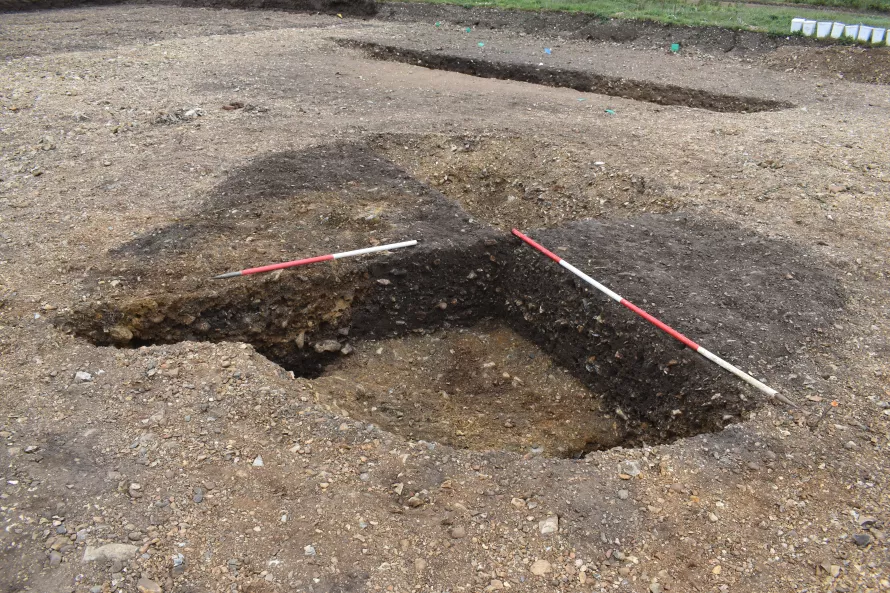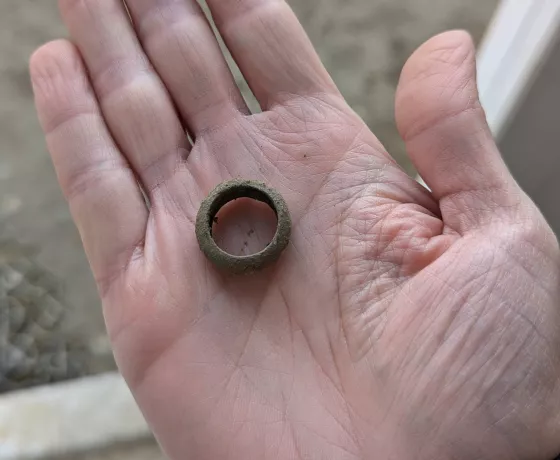If you’ve been following along with us from the start, you’ll know already that we were expecting to find quite a lot of Anglo-Saxon remains on site…and we certainly are not disappointed! If you asked an archaeologist “what’s the first thing that comes to mind when you think of the Anglo-Saxon period?”, probably nine times out of 10 we would reply with “SFB”. And out here at Bury we have a real abundance of them – probably at least 40. If you look back at our Week 1 post, you’ll see that we briefly talk about these structures, but just in case, here’s a recap:
An SFB is shorthand for Sunken Feature Building. But these structures can also go by several other names…Sunken Floor Building, grub-hut, pit-house or Grübenhaus. An SFB is a small to medium sized rectangular structure which are generally believed to have been used as workshops or stores. They’re all pretty much built in the same way, with a rectangular, flat-bottomed pit dug into the ground and a posthole at the centre of either end. This posthole would have supported an upright post which would have formed the frame of the building. Below is a reconstruction of what archaeologists believe these buildings might have looked like.

Reconstruction of an Anglo-Saxon sunken feature building. Image courtesy of dun_deagh on Flickr
There’s a constant to-and-fro about whether the sunken base of SFBs was used as the actual floor surface or whether they had wooden floorboards over the sunken base. Trying to work this answer out is mostly centred on what artefacts we find sitting on the base of these features and whether we think they are in situ (which is a fancy way of saying that an object is in its natural or original position). The evidence at this site would suggest that we have both! Some of our SFBs are getting on for 1m deep, so it’s very unlikely that people would be working in a feature that deep. So, if they did have suspended floors, then we have to ask what’s the point of digging the rectangular pit? One answer is it could have been used as a storage area.
One of the main things we like about SFBs is that they usually contain a lot of cool stuff. Back in the 5th century AD they didn’t have recycling and bin collections, so what are you going to do if you have a load of rubbish you want to get rid of? Well, you’re going to chuck it in a hole. And why go to the effort of digging a hole when you have a deteriorating SFB nearby that no one is using anymore? So, you’re obviously going to throw your rubbish away in that. And that’s what we’re finding in the backfill of these features, lots and lots of rubbish!

Animal bone found in a sunken feature building.
The finds assemblages coming out of our SFBs are dominated by animal bone remains, but we’re also getting lots of pottery. Our Anglo-Saxon’s were hoarders by the looks of things, because considering we don’t have any Roman remains on the site, we’re recovering quite a lot of Roman pottery. But in reality, this is probably similar to us keeping that china teapot which granny gave us but we don’t really know what to do with, so it sits on a shelf till someone either breaks it or says enough and throws it away.

Roman pottery from a sunken feature building.

Roman tile from a sunken feature building.
Traditionally though, you do also tend to get quite a lot of metal objects and worked bone in SFBs and these items are really helping us understand the community that lived and worked here. So here are a few snaps of some of the nice things we’ve recovered recently…









